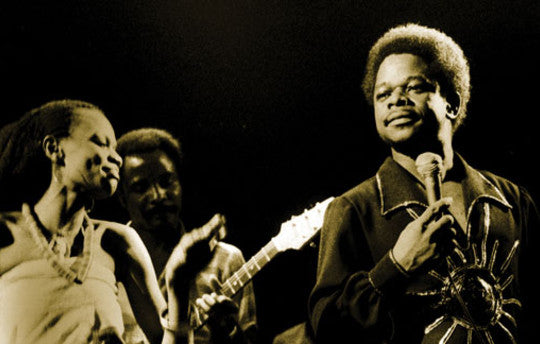Your Cart is Empty

The Congolese rumba was a musical form that hit a nerve throughout Africa and had a bigger cumulative effect on Western dance floors than any other African music.
There are two countries called Congo—The Democratic Republic of the Congo (DRC) and the Republic of the Congo. While both capital cities have been involved in the musical developments, it is the capital of the DRC, Kinshasa, that has provided most of the Congolese superstars. Kinshasa was Africa’s undisputed musical heart, pumping out and endless flow of dance music and great bands. Each generation brought its own style, but all played music known in the West as rumba or soukous.
Rumba Roots
Afro-Cuban rumba stormed West and Central African before and after World War II. It was quickly reappropriated by the Congolese who adapted the piano part for the guitar. Unlike Ghanaian highlife, Congolese music was less influenced by European taste and in many ways more African.
The forefathers of Congolese music include Feruzi, often credited with popularizing the rumba in the 1930s. The cross-border popularity of Congolese music was boosted by a number of practical factors. It was 'non-tribal', using the interethnic trading language, Lingala. The guitar style was an amalgam of influences from Central and West Africa. Finally, postwar Belgian Congo was booming and traders were taking advantage of the commercial potential including the sale of records. Early Congolese labels released a deluge of 78rpm recordings and in the early 1940s Radio Congo Belge started African music broadcasts.
The music scene really came alive in 1953 with the inauguration of African Jazz, the first full-time recording and performing orchestra. Three years later, 'Franco' Luambo Makiadi and colleagues formed OK Jazz. African Jazz created an international-sounding fusion whereas OK Jazz was rootsier and drew on traditional folklore rhythms and techniques. African Jazz, featuring guitarist Nicholas 'Dr Nico' Kasanda, ensured musical immortality with the 1960 release of 'Independance Cha Cha', which celebrated the end of colonial rule.
The 1950s and 60s saw constant movement of musicians between the Belgian and French colonies and a mood of optimism gave the region its good-time reputation. Hundreds of dance bands formed following independence in 1960, including the group Afrisa.
In the 1970s student groups, like Thu Zahina, started a new stream of pop music, picking up on the Western rock-group format. The new music was raw and energetic, with interactive guitars and almost no horns. It took elements from shanty-town music and wordplay, bringing an extra vitality to the music.
It was the group Zaïko Langa Langa that lead the way for the whole post-independence generation. Unlike other bands, Zaïko was not the personal property of one leader. It was a group of over twenty musicians. Other New Wave groups appeared in the 1970s, featuring a rough, sweaty feel while the singers compensated with honey-toned vocals.
Soukous really entered international markets during the 1980s when musicians began recording in Europe. Four Stars was an early success, although OK Jazz and Afrisa were still thriving and releasing international albums.
During the mid-1980s, Mbilia Bel joined Afrisa and became one of Africa’s first female superstars. Women artists were able to experiment with European-style ballads while the men had to stick to dance formulas. More recently, Tshala Mwana has found fame as the queen of mutuashi, a funk-folk rhythm of the Baluba.
Overall, the Kinshasa music scene was suffering on account of socio-political upheavals in the 1990s. However, a showcase event in 1993 demonstrated that the music had not been silenced. A few subsequent festivals helped keep the momentum, but further upheavals in the mid- to late-1990s set Congolese music back.
In the absence of a vibrant music scene, many stars turned to religion. Other artists reverted to folklore, starting the neo-folklore music in 1989 beginning with Swede Swede. Other musicians unplugged and started the acoustic revival. Now, Congolese musicians perform for their own constituents, marking its move out of the limelight and transformation into an underground artform.
You can now study these genres through our partner site World Music Method. Click HERE to view the list of courses.